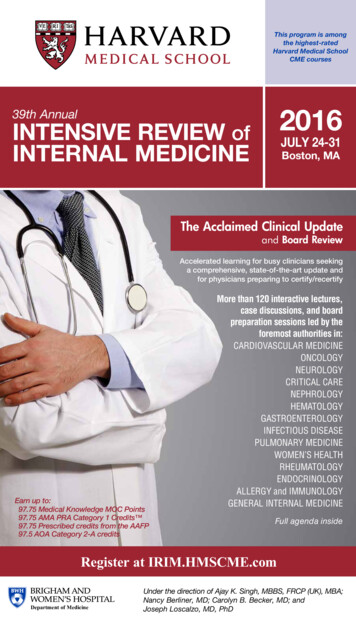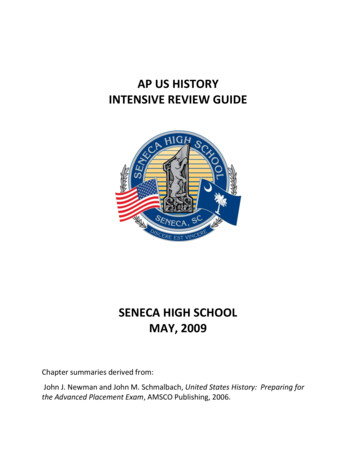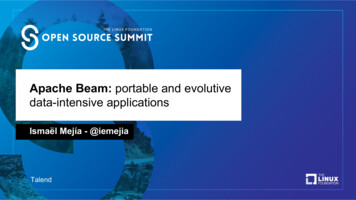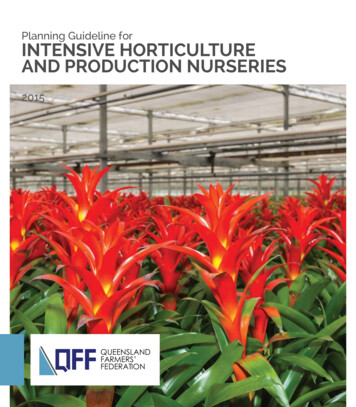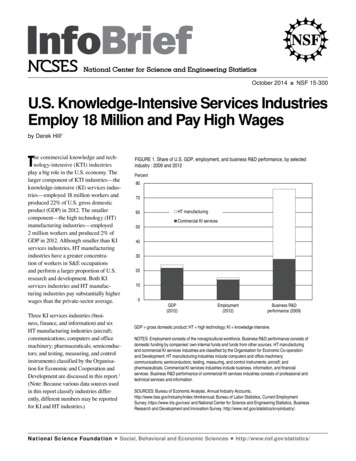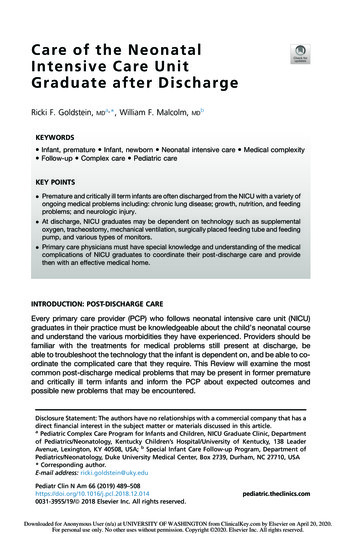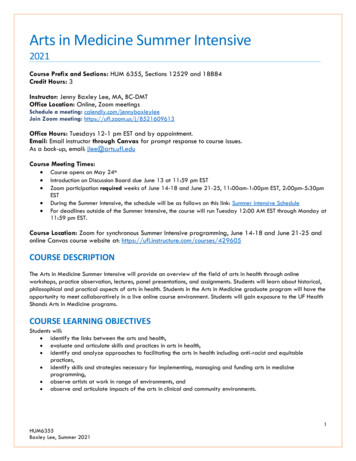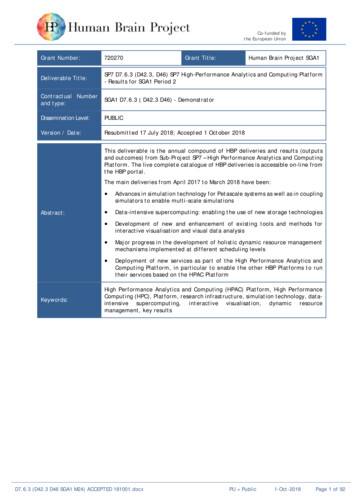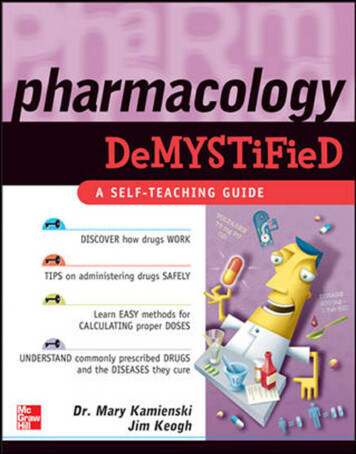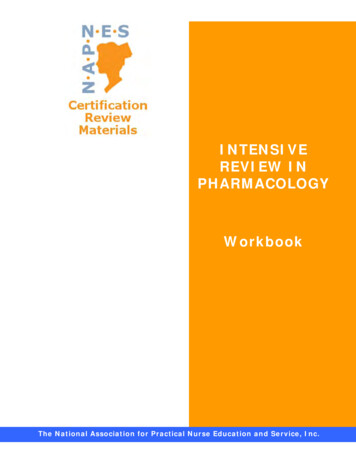
Transcription
INTENSIVEREVIEW INPHARMACOLOGYWorkbookThe National Association for Practical Nurse Education and Service, Inc.
Intensive Review in Pharmacology Workbook, 2nd EditionPublished by:NAPNESNational Association for Practical Nurse Education and Service, Inc.PO Box 25647Alexandria, VA 22313Text and art copyright 2007 by The National Association for Practical NurseEducation and Service, Inc (NAPNES). All rights reserved. No part of this book,including interior design, cover design, logos, and icons may be reproduced ortransmitted in any form, by any means (electronic, photocopying, recording, orotherwise) without the prior written permission of the publisher.Printed in the United States of America.For general information on NAPNES books and other educational material, please callour Education Department at 703-933-1003. For reseller information, includingdiscounts and premium sales, please call our Executive offices at 703-933-1003.For information on where to purchase NAPNES’ educational products, visit our websiteat www.napnes.org or call us at 703-933-1003.For information on using NAPNES’ educational materials in the classroom, or orderingexamination copies, contact our Educational Department at 703-933-1003.For authorization to photocopy items for corporate, personal, or education use, pleasecontact Copyright Clearance Center, PO Box 25647, Alexandria, VA 22313.Limit of Liability / Disclaimer of Warranty: Author and Publisher have used their bestefforts in preparing this book. The National Association for Practical Nurse Educationand Service, Inc. (NAPNES) and Authors make no representation or warranties withrespect to the accuracy or completeness of the contents of this book and specificallydisclaim any implied warranties of merchantability or fitness for any particular purposeand shall in no event be liable for any loss of profit or any other commercial damage,including but not limited to special, incidental, consequential, or other damages.Trademarks: All brand names and product names used in this book are trademarks,registered trademarks or trade names of their respective holders. NAPNES is notassociated with any product or vendor mentioned in this book.in all forms is a trademark of theNational Association for PracticalNurse Education and Service, Inc.1
From the Desk ofConstance Butherus, MA, RNChairperson – Council of Practical Nurse EducatorsNational Association for Practical Nurse Education and Service, Inc.Dear Colleague,It is with great pleasure that NAPNES Department of Education offersyou the Intensive Review in Pharmacology Workbook. It is ourhope that this workbook will help you as you participate in the any ofour Intensive Review in Pharmacology programs. The workbook isdesigned to present you with a hard copy of the slides used in theeducational programs and space for you to add your own notes.Regardless of your motivation in taking the course be it NAPNESCertification in Pharmacology, continuing education or just a generalrefresher / knowledge builder; participation in this program showsyour professionalism and commitment to quality patient care. We atNAPNES Department of Education are always anxious to provideLicensed Practical / Vocational Nurses, P/VN Students and P/VNEducators with opportunities to increase their knowledge andcompetency.I also want to express my sincere gratitude to the members of boththe Education Department and Education Committee at NAPNES.Without their support and dedication, programs like this would not bepossible. Our thanks to NAPNES executive staff as well, their tirelessefforts bring these materials to life. Finally, my thanks to the entiremembership of NAPNES, without your support we would not exist andwe would be unable to create these programs.I hope you find the Intensive Review in Pharmacology programeducational and helpful to you and your practice. I encourage you tocontact us with any thoughts or suggestions that you may have.SincerelyConstance Butherus, MA, RNConstance Butherus, MA, RNChairpersonCouncil of Practical Nurse Educators2
Intensive Review in PharmacologyTable of ContentsSlide Show Note Pages Objectives .Overview .Pharmacokinetics ,.Pharmacodynamics .Pharmacotherapeutics Pharmacognosy Nursing Process in Pharmacology .Medications Effecting the Central Nervous System Antibiotics and Anti-Infectives .Medications Effecting Respiratory Function .Medications Effecting the Gastrointestinal System .Diabetic Medications .Cardiovascular and Renal Medications .45556777101921242729Appendix 234––––Pharmacology Overview .CNS Medications .Antibiotics & Anti-Infectives .Respiratory / GI /CV/ Renal .Appendix BPrevention of Medication Errors Dangerous Abbreviations Error-Prone Drug Information .Five-Rights of Medication Administration .Sound Alike / Look Alike Drugs .B1B2B2B3B4Appendix CMath Skills for Nurses C 1Math for Nurses Practice Exam . C20Appendix DComprehensive Practice Exam . D1
The National Association for Practical Nurse Education and Service, Inc.PresentsIntensive Review inPharmacologyCompanyLOGO(c) Copyright 2000 NAPNES.All rights reserved.2FBI WARNINGFederal Law provides severecivil and criminal penalties forthe unauthorized duplication orexhibition of copyrighted motionpictures, video tapes, videodiscs, or computer software.CompanyLOGO(c) Copyright 2000 NAPNES.All rights reserved.1The National Association for Practical Nurse Education and Service, Inc.AcknowledgesBenita Vaughns, RN, MSNFor her professional workin presenting this program.CompanyLOGO(c) Copyright 2000 NAPNES.All rights reserved.3RECOMMENDED STUDY MATERIAL SThe following may be ordered directly fromNAPNES by visiting: www.napnes.orgor Calling 703-933-1003 logyPharmacologyCompanyWorkbookCD SetDVD SetPC SoftwareLOGO4(c) Copyright 2000 NAPNES.All rights reserved.4
ObjectivesDiscuss general principles ofpharmacologyDiscuss the use of the nursing process asa tool for safe and effective drug therapyDescribe key principles of drug therapy formajor body systemsIdentify principles useful for developing aplan for independent preparation for theNAPNES certification examination7(c) Copyright 2000 NAPNES. All rights reserved.Pharmacology OverviewPharmacology: The study of drugsand their effect on living organismsFive interrelated sciences macotherapeuticsPharmacognosy8(c) Copyright 2000 NAPNES. All rights reserved.PharmacokineticsWhat the body does to the drugAbsorptionDistributionMetabolismExcretion9(c) Copyright 2000 NAPNES. All rights reserved.PharmacokineticsWhat the body does to the drugAbsorptionFrom route of administration to circulationFactors Affecting AbsorptionRoute of AdministrationDosage FormGI d Terms Bioavailability Bioequivalence First-pass Effect(c) Copyright 2000 NAPNES. All rights reserved.5
PharmacokineticsWhat the body does to the drugAbsorptionRelated TermsDistribution Drug-drug interactionFrom Circulation to Site of Action Blood-brain barrierFactors Affecting Distribution Placental barrier Drug blood levelProtein Binding Ability General/selectiveOther MedicationsIncreased or Decreased Blood FlowMedication CharacteristicsMetabolismExcretion11(c) Copyright 2000 NAPNES. All rights reserved.PharmacokineticsWhat the body does to the drugAbsorptionDistributionMetabolismRelated Terms Metabolites Enzyme induction Enzyme inhibitionBiotransformationOther SiteLungs, Kidneys, Plasma, Intestinal MucosaFactors Affecting MetabolismType of DrugDisease State of ClientExcretion12(c) Copyright 2000 NAPNES. All rights reserved.PharmacokineticsWhat the body does to the ed Terms Half-life Steady statePrimary Site – KidneysOther SitesLungs; Sweat, Salivary, & Mammary GlandsFactors Affecting Excretion13Other Drugs Being TakenAltered Kidney FiltrationUrine pH(c) Copyright 2000 NAPNES. All rights reserved.PharmacodynamicsWhat drug does to the bodyReceptor interactionEnzyme interactionNonspecific14(c) Copyright 2000 NAPNES. All rights reserved.6
PharmacotherapeuticsAssessmentDrug historyPregnancy/breast-feeding statusConcurrent ReplacementPalliativeSupportiveProphylactic15(c) Copyright 2000 NAPNES. All rights reserved.PharmacotherapeuticsMonitoringTherapeutic indexDrug concentrationPatient’s conditionInteractions/ReactionsOther drug effectsReassessmentOngoingRegularly16(c) Copyright 2000 NAPNES. All rights reserved.PharmacognosySources of DrugsPlantsAnimalsMineralsLaboratory synthesis17(c) Copyright 2000 NAPNES. All rights reserved.Nursing Process in Drug TherapyParallels pharmacotherapeutics but is more holistic because of theeffects of the drug on every aspect of the person’s life isconsidered.Nursing ionReassessment18(c) Copyright 2000 NAPNES. All rights reserved.7
/psychologicalEnvironmental influencesNursing Diagnoses19(c) Copyright 2000 NAPNES. All rights reserved.PlanningPrioritizing Nursing DiagnosesIdentification ofGoalsOutcomes20(c) Copyright 2000 NAPNES. All rights reserved.Implementation5-RightsDrug (“Know the drug you are giving”)DoseD/H x Q, mg/kg/day, BSA, Clark, Young, FriedI.V. calculations: V/T x CTime (standard/24-hour clock)RoutePatientIdentificationApproach21(c) Copyright 2000 NAPNES. All rights reserved.EvaluationRecognize therapeutic effectivenessRecognize adverse effectsReport therapeutic and adverseeffectsDocument therapeutic and adverseeffectsModify the plan as necessary22(c) Copyright 2000 NAPNES. All rights reserved.8
Special ConsiderationsLegalKnow your legal boundariesBe familiar with both federal & state lawsEthicalTrial DrugsNew DrugsCulturalYour’sClient’sHealth care system23(c) Copyright 2000 NAPNES. All rights reserved.CHECKPOINT #1CHECK YOUR UNDERSTANDINGIncluded with your DVD are review questions tohelp you check your learning. Pause the DVD nowand answer questions 1-6.This program is also accredited for 8 continuingeducation hours. If you’d like to submit yourreview questions for C.E. credit, please follow thedirections given at the end of this program.PAUSE DVD NOW24(c) Copyright 2000 NAPNES. All rights reserved.(See Appendix A for Check Point 1Questions)(Continued Next Page)9
Medications Effecting theCentral Nervous SystemCompanyLOGO(c) Copyright 2000 NAPNES.All rights reserved.25CNS Drug AnalgesicsPsychotherapeutics26(c) Copyright 2000 NAPNES. All rights reserved.CNS Stimulants(Sympathomimetic Agents)Why take a CNS stimulantIncrease alertness (Analeptics)Appetite control (Anorexiants)Attention Deficit Hyperactive Disorder andNarcolepsyExamples of CNS StimulantsNo-Doz (caffeine)Dexatrim (phenylpropanolamine)Ritalin (methylphenidate)27(c) Copyright 2000 NAPNES. All rights reserved.CNS StimulantsThe Nursing Process for CNS StimulantsAssessmentNeed for the drugContraindicationsHypersensitivitySeizure disorderLiver dysfunctionDrug interactionsVital signsHt. & wt.Other drug use28(c) Copyright 2000 NAPNES. All rights reserved.10
CNS StimulantsThe Nursing Process for CNS StimulantsPlanning (Goals)Normal height and weightImproved sensoriumMinimal sleep deprivationVital signs WNLComplianceHealth psychosocial profileKnowledge of drug29(c) Copyright 2000 NAPNES. All rights reserved.CNS StimulantsThe Nursing Process for CNS StimulantsImplementation (Client Teaching)Avoid other sources of CNS stimulantsOTC, prescription, dietTake medication as prescribedDo not adjust dose unless directed by M.D.Take at least 6 hours before bedtimeTake appetite suppressants 30 to 45 min. before mealsMinimize dry mouth with hard candy, sips offluids30(c) Copyright 2000 NAPNES. All rights reserved.CNS StimulantsThe Nursing Process for CNS StimulantsEvaluationExpected EffectsAdverse EffectsStimulants usually speed up body systemsCardiovascular: palpitations, tachycardia, hypertensionCNS: nervousness, insomnia, headache, blurred visionGI: Nausea, vomiting, diarrhea, abdominal pain, drymouthGU: Urinary frequency, diuresis31(c) Copyright 2000 NAPNES. All rights reserved.CNS DepressantsSedative(Sedative/Hypnotic)Reduces nervousness, excitability, andirritability, without causing sleep.HypnoticCauses sleep.TypesBarbiturates /Benzodiazepines / Misc.*A drug may act as a sedative or hypnoticdepending on the amount of drug given.32(c) Copyright 2000 NAPNES. All rights reserved.11
BarbituratesCNS Depressants(Sedative/Hypnotic)Reduce nerve impulses to cerebral cortex.Uses: Sedative/hypnotic, anesthesia, seizurecontrol/prophylaxis, neonatal jaundice.Side effects: Drowsiness, dizziness, hangover,sleep disturbances.Toxicity/overdose: Sleep, respiratory arrest,coma, death.Overdose treatment: symptomatic,activated charcoal.Drug interaction: Enzyme inducer.33(c) Copyright 2000 NAPNES. All rights reserved.CNS ss activity in the CNS.Uses: Sedation, sleep induction, skeletalmuscle relaxation, anxiety relief, balancedanesthesia.Side effects: Safe side effect profile. Drowsiness,dizziness, lethargy, headache.Toxicity/overdose: Somnolence, confusion,diminished reflexes, coma.Overdose Treatment: Symptomatic,lavage, activated charcoal, Flumazenil.Drug interaction: Not an inducer.34(c) Copyrigh
respect to the accuracy or completeness of the contents of this book and specifically disclaim any implied warranties of merchantability or fitness for any particular purpose and shall in no event be liable for any loss of profit or any other commercial damage, including but not limited to special, incidental, consequential, or other damages. Trademarks: All brand names and product names used .
